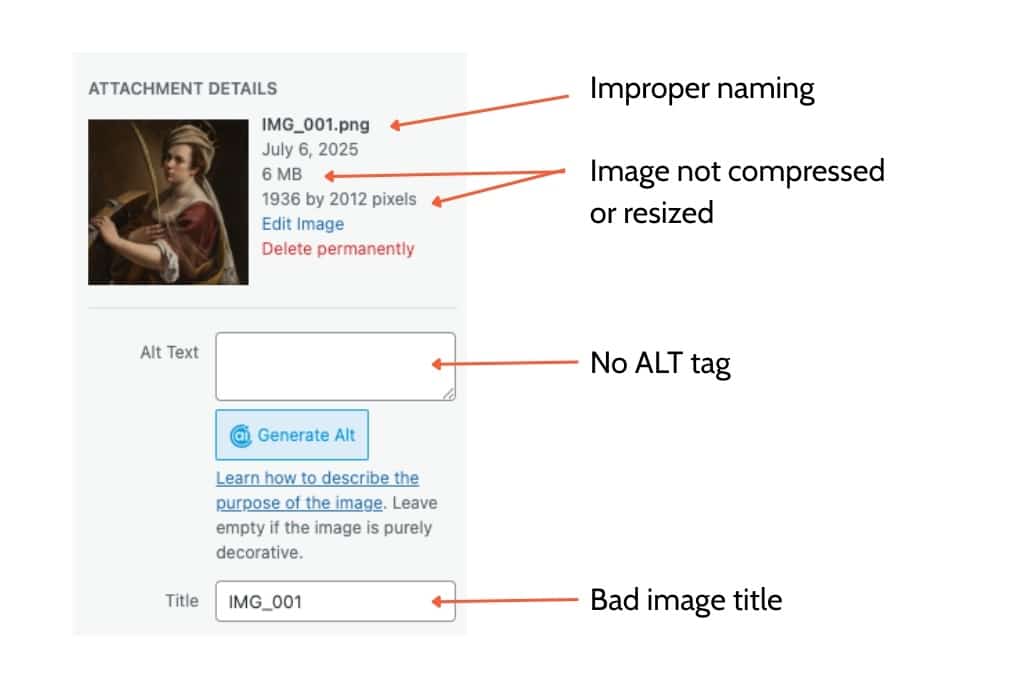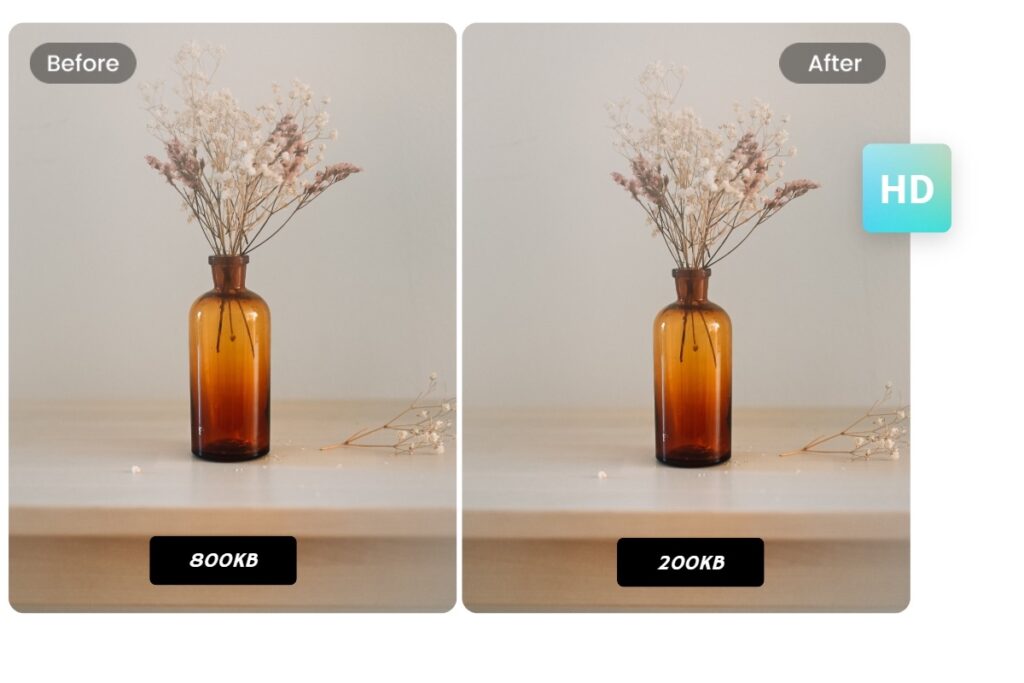Generic visuals no longer serve their purpose, especially in the context of search visibility. Images now have a direct influence on how well your pages rank, but the widespread use of stock photos and AI-generated graphics has led to diminishing returns. As more websites reuse similar imagery, search engines assign less value to it. This shift has redefined what makes visual content effective. It is no longer just about aesthetics. Images must show authenticity, provide meaningful context, and align with the content they support. To evaluate this, search engines use advanced visual AI to analyze image content by detecting objects, reading on-image text, and identifying patterns of duplication across domains. Traditional signals like alt text, file names, and metadata still matter, but they now contribute to a broader process focused on relevance and uniqueness. When the same image appears across multiple sites, it is treated as generic and offers little SEO value.
The need for distinct, original visuals has become even more critical with the rise of large language models (LLMs) and generative AI. These technologies produce content at scale and influence how search engines evaluate what appears online. Platforms like Google are now better equipped to detect patterns associated with automation, duplication, and generic visuals. As a result, original images that show real people, products, or environments have become important ranking factors. They help search engines separate authentic, human-created content from mass-produced or AI-generated material.
That’s why visual content needs to do more than fill space. Search engines are now evaluating how well images align with on-page context and how exclusive they are across the web. So, what does it take for your images to earn trust from search engines and improve rankings?ChatGPT doesn’t follow a fixed set of rules or a strict ranking system to determine which answers appear. While ChatGPT itself doesn’t crawl websites, it often pulls information from search engine-indexed content when using tools like Bing or integrated browsing. Instead, it generates responses by analyzing the context of the user’s query and drawing on patterns from the vast dataset it was trained on. This means it doesn’t pull information from live web searches but predicts the most relevant and coherent reply based on its training. While this flexibility may feel uncertain, it also creates space for businesses to explore new ways of connecting with users through AI-driven conversations. Being included in ChatGPT’s responses can help you reach a larger audience.
Major Platforms Are Shifting to Visual Search
Search engines like Google are evolving their algorithms to place greater emphasis on the quality and originality of visual content. The rollout of AI-driven tools such as Google Lens and the continuous upgrades to Google Images reflect this shift. In 2023, updates like Multisearch and “About this Image” were introduced, offering users richer insights into the authenticity and source of images, further reinforcing the importance of credible, well-optimized visuals in search results.
This shift extends beyond search engines. Major platforms like Amazon and Pinterest are also embracing visual search to transform how users discover products. By allowing searches through uploaded images, they offer a more intuitive and personalized experience. These platforms rely on machine learning to analyze image content and understand user intent, underscoring the increasing importance of original, context-rich visuals in boosting both visibility and engagement.
Visual Content and SEO Still Remain a Challenge for Enterprises and SMEs
Creating original visual content takes effort, skill, and budget. While larger companies often have access to in-house creative teams, design tools, and SEO expertise, smaller businesses usually juggle limited time, budgets, and manpower. As a result, many default to stock images or skip visual optimization altogether. However, this gap in resources shouldn’t result in missed opportunities. Visual SEO is not just about adding an image to a page; it involves strategic choices that combine both technical accuracy and creative relevance. For small teams or businesses with limited resources, staying on top of it all can quickly become overwhelming. Yet cutting corners can hurt performance. Overused or generic visuals reduce credibility, drive bounce rates, and weaken user engagement. On the other hand, original, optimized visuals can enhance search visibility, increase trust, and support long-term SEO gains.
6-Step Process to Futureproof Your Visual Content and SEO in 2025
1. Create and Publish Original Visual & Video Assets
Invest in original photography that captures your real team, workspace, or products. Schedule regular photo shoots or collaborate with professional photographers and designers. Use tools like Adobe Photoshop or Canva to create graphics aligned with your brand tone. For videos, plan content such as behind-the-scenes clips, explainer videos, or product demos. Record with a good camera or smartphone and upload these directly to your website and social media platforms. This helps you stand out in both image and video search results.
2. Optimize Image File Names
Many websites overlook the significance of image filenames. Renaming your image files before uploading is a simple but impactful practice. Avoid default labels like “IMG_4567.jpg.” Instead, use descriptive terms that communicate what the image is about, such as “modern-home-office-desk.jpg.” This helps search engines understand the context of the image, improving its chances of ranking in image search results.
On Windows, renaming can be done by right-clicking the file and selecting “Rename.” On Mac, clicking the filename and pressing Enter allows you to edit. If you’re using WordPress, it’s best to rename files before uploading, as the system doesn’t allow filename changes afterward without third-party plugins like Media File Renamer.
Also, remember to add clear ALT text (alternative text) to every image. ALT tags not only help visually impaired users understand your content, they also give search engines additional clues about your image, boosting your page’s SEO.

3. Implement Structured Data
Search engines use structured data to interpret and rank visual content more accurately. Structured data is a type of code that helps search engines understand what different elements on a page represent. For images, the most relevant markup type is ImageObject, which comes from the Schema.org vocabulary and is usually written in JSON-LD (JavaScript Object Notation for Linked Data). While it’s not a programming language, ImageObject is a structured format used to describe an image’s key details, such as its URL, caption, license, creator, and more. This metadata gives search engines greater context around your images and increases the likelihood of those visuals appearing in rich results like image carousels or featured snippets. You can implement structured data manually through JSON-LD in your website’s HTML. If you’re using WordPress or a CMS, tools like Google’s Structured Data Markup Helper or plugins like Schema Pro and Yoast SEO offer easy, no-code options. Additionally, structured data also enables visual badges in Google Images and improves content visibility in Discover feeds, making your visuals more discoverable and engaging.
4. Compress Images Without Losing Quality
Large images can significantly slow down your website, which affects both SEO performance and user experience. Search engines like Google consider page speed a ranking factor, and users are more likely to abandon pages that take too long to load. Compressing images before upload ensures your visuals load quickly without compromising quality. While WordPress plugins like Smush, ShortPixel, or EWWW Image Optimizer can compress images after upload, doing it beforehand gives you greater control over file quality and size. It also reduces the load on your hosting server and helps you avoid plugin limitations, which is especially useful when uploading images in bulk. For best results, make it part of your workflow to manually optimize every image using free tools like TinyPNG, Squoosh, or ImageOptim before adding them to your CMS.

5. Optimize and Embed Video Content Strategically
Videos are powerful for SEO, but only when used wisely. Instead of uploading videos directly to your site (which slows down page speed), host them on platforms like YouTube or Vimeo. Embed them using clean HTML (like <iframe> or HTML5 video tags) to ensure responsive playback.
To maximize visibility, optimize metadata by adding keyword-rich titles, descriptions, and tags. For better accessibility and indexing, include closed captions and consider uploading a video transcript to your site. These practices boost user engagement and improve discoverability in search results.
6. Monitor Performance and Refine Your Strategy
Visual SEO is not a one-time effort. It requires consistent monitoring and refinement to stay effective. Use tools like Google Search Console to evaluate how your images are performing in search, including impressions and click-through rates. Google Analytics can provide further insight into how visual elements influence key engagement metrics such as bounce rate, average time on page, and conversion rates. To gain deeper insights, use platforms like Hotjar or Microsoft Clarity, which provide visual heatmaps and session recordings.
Use these insights to regularly audit your visual content. Replace low-performing images, reposition elements, and revise alt text based on user behaviour and search performance. Make it a habit to review your visual content strategy quarterly to keep pace with evolving algorithms and audience expectations.
These steps lay the groundwork for effective visual SEO, but staying ahead means keeping up with evolving trends that shape how platforms rank and prioritize images.
Top Trends in Visual Content and SEO
- AI-Generated Visuals with Authenticity Checks: Google is deploying detection filters to demote synthetic visuals without clear added value.
- Video SEO: Videos are becoming central to content strategies. Transcriptions, captions, and metadata optimization enhance visibility on search engines.
- Mobile-First Visuals: With mobile searches dominating, images must be optimized for fast loading and clarity on small screens.
- Interactive and 3D Visuals: Augmented reality (AR) and interactive images are gaining traction, especially in e-commerce and real estate sectors.
- Visual Search Optimization: Optimizing images for reverse image search and using schema markup to provide contextual details boosts discoverability.
Conclusion: Visual SEO Demands Originality, Intent, and Strategy
Visuals are no longer just decorative elements on a page. They now define how content is understood, ranked, and remembered. With large language models increasingly capable of interpreting both images and text, visual content plays a direct role in SEO, brand perception, and engagement. But performance isn’t driven by strategy alone. In 2025 and beyond, the impact of visuals will depend on their authenticity, the clarity of their purpose, and the human intention behind their creation. Search engines and social platforms are evolving to reward images that feel real, represent actual people or products, and serve a meaningful role within the user journey. Highly polished visuals that lack context or depth will fall short. What matters is whether your images add value, reflect truth, and support your content goals. A data-informed visual SEO strategy remains essential, but its effectiveness comes from being rooted in originality, trust, and genuine purpose.

